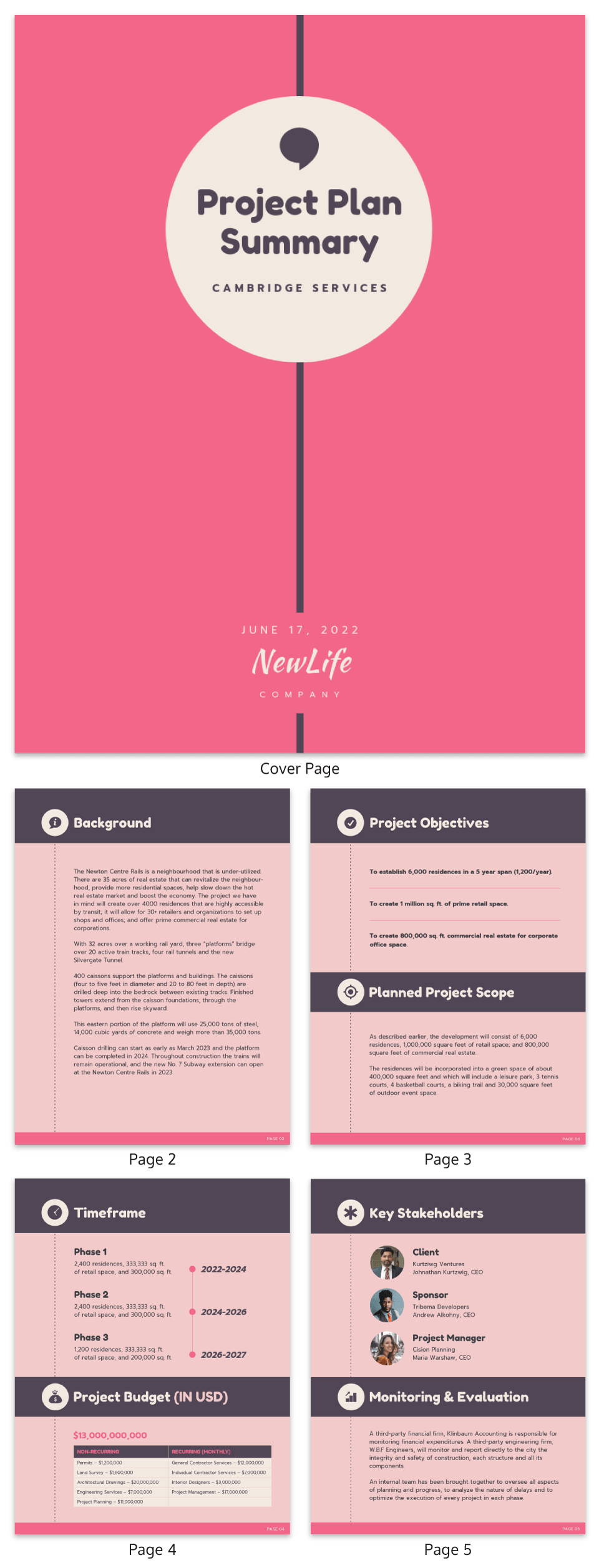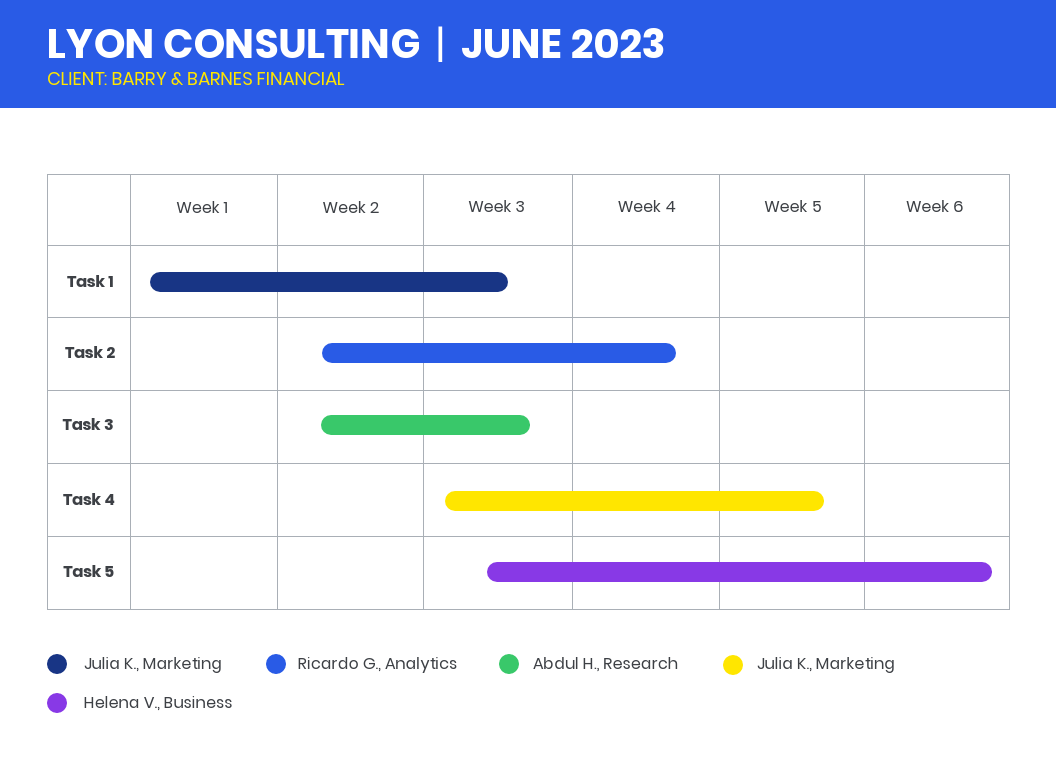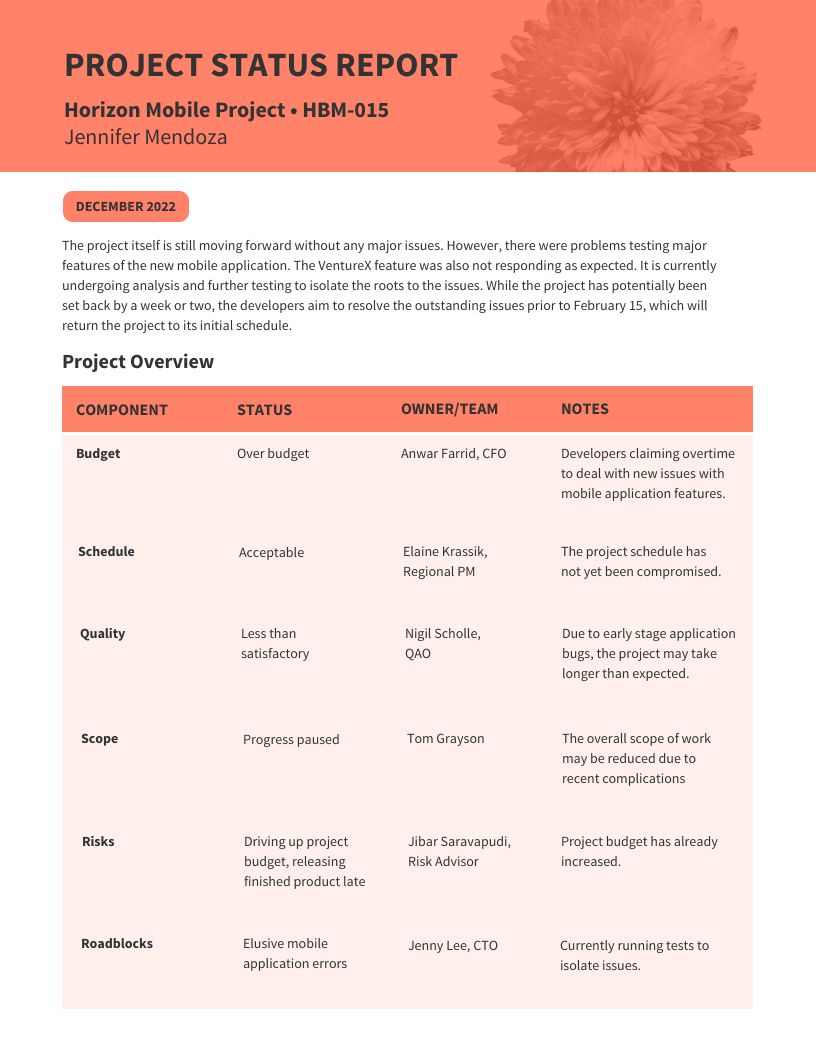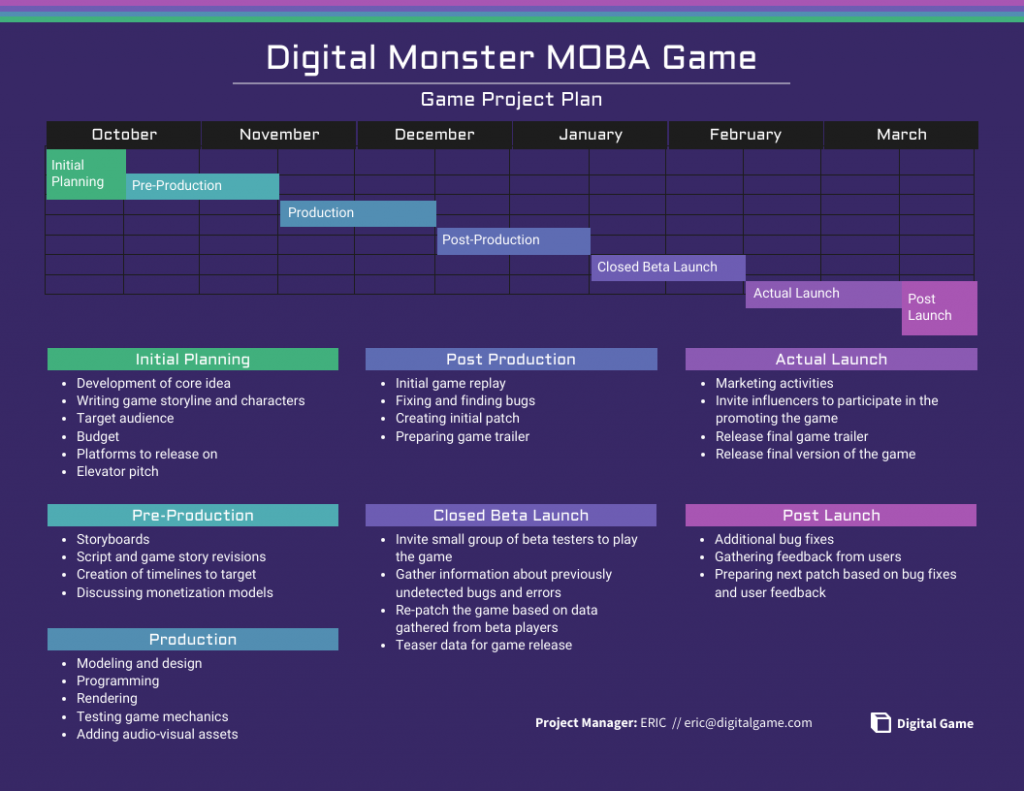
Have you ever been part of a project that didn’t go as planned? It doesn’t feel good. Wasted time, wasted resources. It’s pretty frustrating for everyone involved. That’s why it’s so important to create a comprehensive project management plan before your project gets off the ground.
Nearly 60% of project managers believe that poor project planning has a negative impact on the overall project success. So, how do you do efficient project planning?
In this guide, we’ll explore how to create and design a successful project management plan.
We’ll also showcase easy-to-customize project plan templates you can create today with our user-friendly drag-and-drop editor. Let’s get started!
What is a project management plan?
A project management plan is a formal document that defines how a project is going to be carried out by outlining the scope, goals, budget, timeline and deliverables of a project. Its crucial role lies in ensuring the project stays on course.
According to the study by Project Management Institute, lack of clearly defined objectives and project goals is one of the key factors for project failure. A project plan helps you list the project objectives, scope, communication method and potential outcomes to execute project successfully.
You write a project plan during the project planning stage of the project life cycle, and it must be approved by stakeholders before a project can move on the execution stage.
If some of these terms are new to you, you can get up to speed with this post on project management terms.
This means your project plan must be engaging, organized, and thorough enough to gain the support of your stakeholders.

Project management plan templates and examples
A project management plan is probably the most important deliverable your stakeholders will receive from you (besides the project itself).
It holds all of the information that stakeholders will use to determine whether your project moves forward or gets kicked to the curb.
That’s why it’s a good idea to start with a project management plan template. Using a template can help you organize your information logically and ensure it’s engaging enough to hold your stakeholders’ attention.
1. Sample business project management plan example
Here’s an example of a simple business project management plan for all companies and industries. It includes a simple project overview, timelines and budget. This example works for all simple projects with a limited number of stakeholders.
2. Construction project management plan template
Time is money, especially with construction projects. Having a construction plan template brings order to the chaos.
Instead of staring at a messy pile of construction stuff, you’ve got a plan that breaks everything down into bite-sized pieces.
And let’s not forget the paperwork. Construction projects have rules and regulations to follow. Your project plan helps you stay on the right side of the law with all the necessary documentation and compliance measures.
Start with a meticulous project overview, like in the second page of this template:

Though you may think this project will be similar to others you’ve done in the past, it’s important to nail the details.
This will also help you understand the scope of work so you can estimate costs properly and arrive at a quote that’s neither too high or low. Ontario Construction News has great advice on this process.
3. Simple project management plan template
This simple project management plan template that clearly lays out all of the information your stakeholders will need:

Related: 14 Individual Development Plan Examples & Templates
4. Simple project management communication plan template
A key part of project management is making sure everyone’s in the loop. A project communication plan ensures everyone knows how, where, who and when the team will communicate during the course of the project. Also construction scheduling is a critical aspect of the project management plan as it helps to ensure that all necessary tasks are completed within the allocated time frame and budget.
The key is to figure out what kind of communications is valuable to stakeholders and what is simply overwhelming and won’t lead to better decisions.
This template clearly outlines all of these factors to help manage expectations and eliminate confusion about what will get communicated and when:
5. Commercial development project plan template
The below project management plan template is simple and minimal, but still uses a unique layout and simple visuals to create an easy-to-read, scannable project overview.
This template is perfect for building or construction management, or any technical projects:
When picking a project plan template, look for one that’s flexible enough to accommodate any changes your stakeholders might request before they’ll approve the project. You never know what might change in the early planning stages of the project! You can also use project management tools to help you with your planning!
6. Project marketing plan template
Let’s say you are working on a solid project idea that could help your business grow revenue. But, how to do make your customers or stakeholders aware of the project? This is where you need a project marketing plan template to plan and execute marketing strategies in different phases of the project.
7. Game development project plan template
This template is for the software developers or engineers working on a new gaming project. It’s simple plan in the form of a Gantt chart that explain different project phases and when they will be executed. This plan lists all the action items required for smooth project execution.
8. Environmental project plan template
This environmental project plan template is for NGOs working on environmental projects. The minimalist green layout and the images aligns perfectly with the environment theme. You can easily customize the project overview, goals and budget sections to share more details about your project.
9. Risk mitigation project plan template
Risk mitigation is an integral part of project planning. You need to identify potential risks before starting a project and map strategies to prevent the risks. This Risk Mitigation Matrix Template helps you deliver projects successfully. Start by listing potential risks and their impact or severity and identify which risks can be tolerated and which are unacceptable.
10. Data migration project plan template
Are you transferring your company data to the cloud or changing the vendor? You need a solid project plan to ensure all the files are transferred successfully and safely. This data migration project template makes it easier to plan the data migration process.
What is the importance of a project management plan?
A well-developed project management plan sets the foundation for a successful project by providing a roadmap that guides the project team toward successful project completion. A good project management plan can ensure that:
- Project objectives and goals are clearly defined and understood
- Project scope is effectively managed
- Resources are allocated efficiently to maximize productivity and minimize waste
- Risks are identified, assessed and mitigated
- Project tasks and activities are well-organized and executed in a timely manner.
- Communication among team members, stakeholders and project sponsors is effective and transparent
- Changes to the project are properly evaluated, approved and implemented
- Lessons learned and best practices are documented for future reference and improvement
- Stakeholders are engaged and satisfied with the project outcomes
- The project is delivered within the specified timeline, budget and quality standards
What should a project management plan include?
Before you start assembling your own plan, you should be familiar with the main components of a typical project plan.
A project management plan should include the following sections:
- Executive summary: A short description of the contents of the report
- Project scope & deliverables: An outline of the boundaries of the project, and a description of how the project will be broken down into measurable deliverables
- Project schedule: A high-level view of project tasks and milestones (Gantt charts are handy for this)
- Project resources: The budget, personnel, and other resources required to meet project goals
- Risk and issue management plan: A list of factors that could derail the project and a plan for how issues will be identified, addressed, and controlled
- Communication management plan: A plan for how team and stakeholder communication will be handled over the course of the project
- Cost and quality management plan: This section encompasses the project’s budget, cost estimation, and cost control mechanisms. It also includes quality assurance testing and control measures as well as any testing or verification activities to be performed.
Basically, a project plan should tell stakeholders what needs to get done, how it will get done, and when it will get done.
That said, one size doesn’t fit all. Every project management plan must be tailored to the specific industry and circumstances of the project. You can use a project management app for smoother project planning.
This commercial development plan focuses on specific objectives and a detailed timeline:
With those basics out of the way, let’s get into how to write a project management plan that’s as engaging as it is professional.
Further Reading: If you’re looking to create a proposal, read our in-depth business proposal guide. Then try our job proposal templates or business proposal templates.
How do you write a project management plan?
To write a successful project management plan, follow these 5 steps below to create an effective plan that serves as a valuable tool for project management:
1. Highlight the key elements of your project plan in an executive summary
An executive summary is a brief description of the key contents of a project management plan. It’s usually the first thing stakeholders will read, and provides an overview of the whole project plan.
The summary describes a project’s value proposition, goals, deliverables, and important milestones, but it has to be concise (it is a summary, after all). First, make sure you develop a proof of concept.
In this example, an executive summary can be broken into columns to contrast the existing problem with the project solution:

The two-column format with clear headers helps break up the information, making it extremely easy to read at a glance.
Here’s another example of a project management plan executive summary. This one visually highlights key takeaways with big fonts and helpful icons:

In this case, the highlighted facts and figures are particularly easy to scan (which is sure to make your stakeholders happy).
But your executive summary won’t always be so simple.
For larger projects, your executive summary will be longer and more detailed. Using an online summarizer can help streamline this process by focusing on the project’s key highlights most relevant to executives
This project management plan template has a text-heavy executive summary, though the bold headers and different background colors keep it from looking overwhelming:
It’s also a good idea to divide it up into sections, with a dedicated header for each section:

Regardless of how you organize your executive summary, it should give your stakeholders a preview of what’s to come in the rest of the project management plan.
2. Plot your project schedule visually with a Gantt chart
A carefully planned project schedule is key to the success of any project. Without one, your project will likely crumble into a mess of missed deadlines, poor team management, and scope creep.
Luckily, project planning tools like Gantt charts and project timelines make creating your project schedule easy. You can visually plot each project task, add major milestones, then look for any dependencies or conflicts that you haven’t accounted for.
For example, this Gantt chart template outlines high-level project activities over the course of an entire quarter, with tasks color-coded by team:

A high-level roadmap like the one above is probably sufficient for your project management plan. Every team will be able to refer back to this timeline throughout the project to make sure they’re on track.
But before project kickoff, you’ll need to dig in and break down project responsibilities by individual team member, like in this Gantt chart example:

In the later execution and monitoring phases of the project, you’ll thank yourself for creating a detailed visual roadmap that you can track and adjust as things change.
You can also use a project management tool to keep your team organized.
Further Reading: Our post featuring Gantt chart examples and more tips on how to use them for project management.
3. Clarify the structure of your project team with a team org chart
One of the hardest aspects of project planning is assembling a team and aligning them to the project vision.
And aligning your team is all about communication–communicating the project goals, communicating stakeholder requests, communicating the rationale behind big decisions…the list goes on.
This is where good project documentation is crucial! You need to create documents that your team and your stakeholders can access when they have questions or need guidance.
One easy thing to document visually is the structure of your team, with an organizational chart like this one:

In an organizational chart you should include some basic information like team hierarchy and team member contact information. That way your stakeholders have all of the information they need at their fingertips.
But in addition to that, you can indicate the high-level responsibilities of each team member and the channels of communication within the team (so your team knows exactly what they’re accountable for).
Here’s another simple organizational structure template that you can use as a starting point:

Create an organizational chart with our organizational chart maker.
4. Organize project risk factors in a risk breakdown structure
A big part of project planning is identifying the factors that are likely to derail your project, and coming up with plans and process to deal with those factors. This is generally referred to as risk management.
The first step in coming up with a risk management plan is to list all of the factors at play, which is where a risk breakdown structure comes in handy. A risk breakdown structure is a hierarchical representation of project risks, organized by category.
This risk breakdown structure template, for example, shows project risk broken down into technical risk, management risk, and external risk:

Once you’ve constructed your risk breakdown structure, you’ll be ready to do a deep dive into each risk (to assess and plan for any triggers and outcomes).
Streamline your workflow with business process management software.
5. Plan ahead: create project status reports to communicate progress to stakeholders
As I mentioned earlier, communication is fundamental in any project.
But even so, something that’s often overlooked by project managers is a communication management plan–a plan for how the project team is going to communicate with project stakeholders. Too often, project communication defaults to ad-hoc emails or last-minute meetings.
You can avoid this by planning ahead. Start with a project kickoff meeting and include a project status report template as part of your communication plan.
Here’s an example of a simple project status report that you might send to stakeholders on a weekly basis:

This type of report is invaluable for communicating updates on project progress. It shows what you’ve accomplished in a clear, consistent format, which can help flag issues before they arise, build trust with your stakeholders, and makes it easy to reflect on project performance once you’ve reached your goals.
You might also want to include a broader status report for bigger updates on a monthly or quarterly basis, like this one:

The above template allows you to inform stakeholders of more major updates like new budget requirements, revised completion dates, and project performance ratings.
You can even include visualization of up-to-date project milestones, like this example below:

Want more tips on creating visuals to enhance your communications? Read our visual communication guide for businesses.
7 key tips for creating a project management plan
Before diving into creating a project management plan, it is crucial to have a clear understanding of the project objectives and the expectations of stakeholders involved.
Without a firm grasp of these fundamental elements, your project may face significant challenges or fail to deliver the desired outcomes.
Here are key points to consider when creating a project management plan:
- Project objectives: Clearly understand the project objectives and what you want to achieve. Identify the desired outcomes, deliverables and the purpose of the project.
- Scope of the project: Determine the boundaries and extent of the project. Define what is included and excluded to ensure clarity and prevent scope creep.
- Stakeholders: Identify all stakeholders who will be impacted by or have an interest in the project. Understand their needs, expectations and level of involvement.
- Resources: Assess the resources required to execute the project successfully. This includes human resources, budget, equipment and materials. Determine their availability and allocation.
- Risks and constraints: Identify potential risks, uncertainties and constraints that may affect the project. Understand the challenges, limitations and potential obstacles that need to be addressed.
- Formatting: Use headers, columns and highlights to make your executive summary easy to read. Plot your project schedule with a Gantt chart (with tasks color-coded by department or team member)
- Visuals: Try using visuals like organizational charts and risk breakdown structures to communicate across your team and with stakeholders. Pick a flexible template that you can update to align with stakeholder requests.
Now that you have these key areas identified, let’s get started with creating your project plan.
Common mistakes to avoid when creating a project management plan
Creating a solid project management plan is crucial for setting your project up for success. Here are some common mistakes to avoid:
- Lack of clear goals: Don’t just have a vague idea of what you want to achieve. Define clear, SMART goals (Specific, Measurable, Achievable, Relevant and Time-bound) for your project. For example, ‘Develop a functional smartwatch prototype with health tracking and Bluetooth within three months, tested by 20 users for feedback.’ That way, everyone will be on the same page and it’ll be easier to measure progress effectively.
- Unrealistic timelines: Be optimistic, but also realistic. Don’t underestimate the time required for tasks. Factor in potential delays and buffer time when creating your project schedule.
- Scope creep: New requirements mid-project can affect deadlines and budgets. Plan the project clearly upfront, and take into consideration any changes that might come up.
- Poor communication: Communication is key throughout the project lifecycle. Regularly update stakeholders, team members and clients on progress, roadblocks and changes.
- Ignoring risks: Things don’t always go according to plan. Identify potential risks upfront and have a mitigation strategy in place for each one.
- Not involving stakeholders: Get key stakeholders involved early on. This helps manage everyone’s expectations and that you have the buy-in you need for success.
- Neglecting resource constraints: Don’t overload your team or underestimate the resources needed. Carefully consider the skills, time and budget available when planning your project.
- Micromanaging: Trust your team! Delegate tasks effectively and give them the autonomy they need to do their jobs.
- Failing to document: Keep good records. Document project decisions, plans and communication. This helps maintain transparency and ensures everyone has access to the latest information.
- Not adapting to change: Be prepared to adapt your plan as needed. Projects are rarely static, so be flexible and willing to adjust your approach based on new information or developments.
So, that’s the scoop on project management plans! I hope this piece will help you to avoid confusion, keep expectations in check and be ready to tackle any bumps for your upcoming projects.
If you ever need a revision, just follow the steps we talked about, use those best practices and you’ll have a plan that sets your project up for a win. Just remember, even the best plans need some tweaking sometimes. Be flexible and adjust as needed and you’re good to go!














































